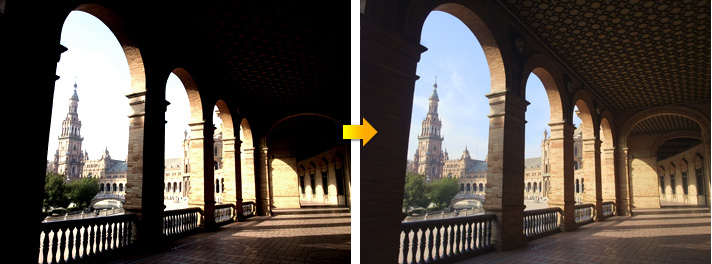The term that I would like to cover first is dynamic range, since it’s probably the most complicated one of all that I will be talking about in this entry. Every single photo that you take includes shadows and highlights. There are a few basic elements that govern the appearance of shadows and highlights in your photos. Shadows and highlights become more or less apparent depending upon the level of contrast in the scene. The level of contrast is determined by the quality of light. Bright sources of light create a lot of contrast while muted sources of light generate less contrast Light that creates strong contrast is also called hard light while low contrast light is called soft light. Hard light creates dark shadows and very bright highlights while soft light makes the shadows and highlights more balanced.
When you're looking at a scene where there's a lot of contrast your eyes are able to see details in both the shadows and highlights. A digital SLR camera can't since they have a limited dynamic range. Since an SLR camera can't capture the entire dynamic range, it has to choose between one of two options. They can either preserve detail in the shadows, over exposing the highlights making the image appear white, or preserve detail in the highlights and under expose the shadows making them appear black.
To fix this, there are several new digital SLR cameras that include enhanced dynamic range. With this, there are two different methods that DSLRs can use to improve the appearance of images with extreme contrast. Make the highlights bright, but prevent them from going to pure white, which helps retain some detail, or expose for highlights, making the shadows dark and then increase the brightness of just the shadows to balance the image. Different brands have different names for this. For Canon and Nikon, it’s called "highlight tone priority" and D-lighting respectively.
Next up is continuous drive. A continuous drive is geared towards action photographers because they need DSLR cameras with a high continuous photo speed and buffer. This is because they know that a fraction of a second is the difference from a pretty good photo and one that is downright exceptional. When you're dealing with fractions of a second, you need a camera that is crazy fast. The two key indicators of the speed of a digital SLR camera are its continuous photo speed and buffer. Every digital SLR camera has a mode where you can take rapid consecutive photos. All you have to do is hold down the camera's shutter release button, and the camera will keep snapping the photos off one by one. Continuous photo speed is the number of photos a camera can take in one second. Specification sheets will often list the continuous photo speed of an SLR in frames per second or FPS, which is equivalent to photos per second. This measurement makes it easy to tell if one camera is faster than another. If one camera has a speed of 5fps while another has a speed of 9fps, the 9fps camera can take more consecutive photos in less time.
An HDSLR is a single camera that can capture both still images and HD video. In 2008, the HDSLR did not even exist. Digital SLR cameras were exceptional at taking still photos, but not a single one could be used to capture a motion picture. All that changed at the end of 2008 with the release of the Nikon D90, the first digital SLR that could capture both stills and video. After that first offering, the race was on: every other camera company had to produce something similar in order to stay "current". But some new term was required to describe these cameras: they weren't really simple digital SLRs anymore, nor were they video cameras (since you can't change out the lens on most consumer video cameras). I might go into more detail about this in the future since digital videography is something different topic from photography.
Now to end with something simple, I want to talk briefly about auto focus. Nearly all DSLRs come with autofocus. In autofocus mode the DSLR will automatically focus on the subject in the center of the viewfinder (although many DSLRs allow you to select other areas to focus on too).
 | |
| Auto Focus Points |
There you have it! Those are most of the terms you should try to familiarize yourself with when you choose your camera. There are a few that I missed but those aren’t as important to know as of now and will definitely be covered as I get into more detail about the different types of photography and methods. So in the meantime I hope you found this useful and happy shooting!


